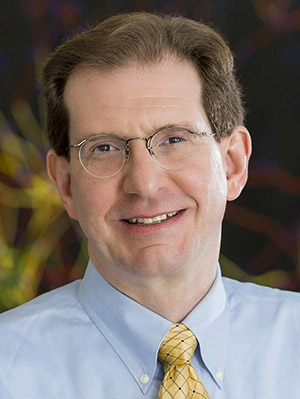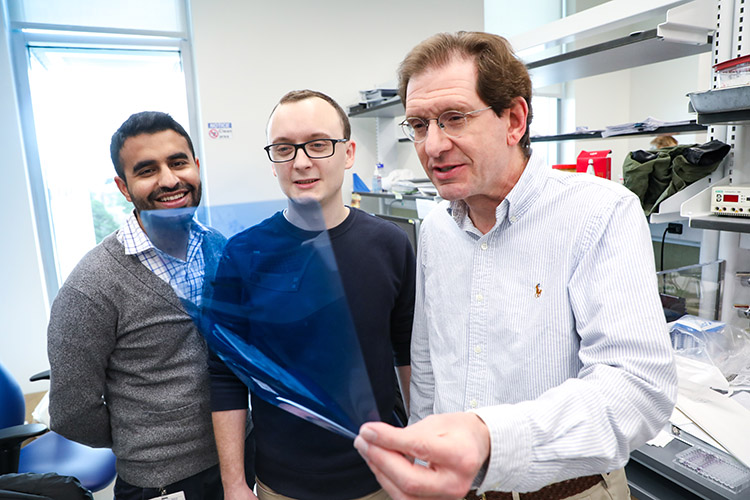
Finding Hope in Darkness: Duke Neurologist Develops and Tests New Therapy to Help Understand and Prevent Neurodegenerative Diseases
Alexandra Angelova was 16 when she began experiencing blurry vision and occasional dizzy spells. Instead of going away, her symptoms gradually grew worse. Now nearly a decade later, with her vision at one percent of its original strength and with balance problems that prevent standing or walking unassisted, these symptoms inform every aspect of her daily life.
Angelova gets around the house and walks her dog, Sunny, using a rollator, or seated walker. She presses her back against the wall for balance when going up and down stairs. Every item in her house has a set location so she can find it with her limited vision.
“I cannot perform many basic things which are normal for a healthy person,” Angelova said. “I have to plan every movement and how to do it--how to hold a fork, how to take a shower, and so on.”
Angelova’s case is typical for people with spinocerebellar ataxia type 7, or SCA7, a chronic, inherited neurodegenerative disease. A child with a parent with SCA7 has a 50 percent chance of inheriting the condition. It is caused by a genetic mutation which causes the body to produce a malformed, toxic version of a normally healthy protein.
People with SCA7 develop normally as children when the body has the ability to filter out these malformed proteins. But sometime during adolescence or adulthood this protective effect disappears. Without it, the malformed proteins destroy cells in the retinas and the cerebellum, the brain’s balance center, taking sight and coordination with them.
Symptoms of SCA7 gradually worsen over time, and there is no cure. Angelova has had to make a series of lifestyle adjustments to compensate. Her eyesight recently deteriorated to the point where she can no longer read books, so she has switched to audiobooks. Adjusting the display of her smartphone to heighten contrast and magnify words and images has allowed Angelova to communicate with family and the outside world.
She works to be as independent as possible, doing her own laundry, cleaning, and shopping, and other tasks, but it’s difficult.
“I insist on doing these things, because it makes me independent and I face these challenges with pleasure,” Angelova says.

Al La Spada, MD, PhD, professor of neurology and director of the Duke Center for Neurodegeneration and Neurotherapeutics, has devoted his career to understanding diseases of the central nervous system and how they affect people like Angelova.
Over the past 25 years, he has seen a revolution take place in our understanding of the central nervous system. Scientists have identified a single unifying cause behind seemingly disparate diseases. Understanding this single cause--neurodegeneration—is key to finding the first effective therapies for these conditions and for making the brain more resilient as we age.
La Spada’s own research resulted in the discovery in 1991 of the origins of a rare neurodegenerative condition known as Kennedy’s disease: a mutation on the X-chromosome that causes what are known as CAG expansions.
Normally that area of the genome contains precise instructions for making androgen proteins.
But for people with Kennedy’s disease, the CAG expansions alter those instructions. The CAG expansions tell the cell to repeat the same instruction—“add the amino glutamine” dozens or even hundreds of times when building the protein.Think of an assembly line that places 70 windshields, one on top of the other, to every car it produces. The proteins misfold and lose their ability to function. Over time they accumulate in the body, reach toxic levels, and kill off neurons in the spinal cord.
Over the next several years, scientists discovered a similar pattern among other seemingly unrelated neurological conditions, from the memory-destroying Alzheimer’s disease, to the paralysis-inducing amyotrophic lateral sclerosis (ALS), to the tremor-causing Parkinson’s disease.
“It became clear that all adult-onset neurodegenerative diseases involve proteins that misfold,” says La Spada. “The diseases involve different proteins, and they accumulate in different places in the central nervous system. We’ve known this for 25 years.”
However, until recently, this discovery hasn’t had many practical applications. In the cases of Alzheimer’s and ALS, science currently provides no explanation for the underlying reason for why proteins misfold and accumulate. And even in conditions like Kennedy’s, Huntington’s, or any of the 7 other diseases caused by CAG expansions, there are no treatments that slow or stop the condition--yet.

La Spada hopes that can change. One promising result is a therapy known as antisense oligonucleotides, or ASOs. ASOs are pieces of DNA that are tailor-made to be mirror counterparts to the faulty RNA instructions within cells. When the ASOs find those molecules, they match with them, preventing the faulty, dangerous proteins from being made.
“ASOs are all about dosage reduction. If these disease proteins are the problem, then the idea is very simple--just prevent them from being made,” says La Spada.
In a study published last year, La Spada’s team injected ASOs into mice with SCA7. Mice whose eyes were treated with ASOs showed improved visual function over time. La Spada is also working with Ionis Pharmaceuticals to develop a similar ASO therapy for human patients with SCA7. Early clinical trials for the condition are planned for next year.
ASOs, while a huge potential step forward for people with genetic forms of neurodegenerative diseases, have their limits. They can block the RNA instructions for neurodegenerative proteins, but they don’t block neurodegenerative proteins that accumulate for other reasons or correct the faulty instructions in the first place. In their current form, ASOs would need to be injected several times a year into the spinal cord or the region of the body affected by the condition. And even if their delivery method improves, a patient would experience therapeutic relief but not a cure.
La Spada sees another avenue for therapy that would take advantage of the natural resiliency of the human brain. Age is the one common factor linking neurodegenerative diseases. Neurodegenerative diseases are most common among the elderly, and they worsen the longer a person has them. Individuals with conditions like Kennedy’s disease or SCA7 have the faulty instructions from birth. Something positive about the young brain allows us to maintain quality control of proteins in a way that the aging brain does not.
“There are very powerful pathways in place in the central nervous system that function optimally and maintain homeostasis while we’re young,” La Spada says. “The problem is that as we age the function of those pathways decline and you reach a tipping point where your body can no longer keep up. If we can understand the pathways that are going awry we may be able to boost their function and develop the first effective treatments for all neurodegenerative disorders. It’s going to be complicated, but it also offers a very exciting hope for offering an effective way to finally offer help to patients with neurodegenerative disorders.”
In the meantime, Angelova draws inspiration from her maternal grandmother, who, like Angelova’s mother, also had SCA7. While Angelova’s mother, like many people with SCA7, became disillusioned after the disease slowly took away her ability to dance, work, drive, and perform other activities, Angelova’s grandmother lived as full a life as she could with SCA7 while also accepting the limitations it imposed on her.
“SCA7 has made my physical life extremely difficult but it taught me how to be a better person and how to appreciate life, it has taught me not to be afraid and take any chance which life offers me,” said Angelova.
“Most people are afraid of failure or think they have time to do everything. I don’t know how much time I have and this is why I choose to take every opportunity, without fearing failure. For me SCA7 is a great lesson, and I chose to make the best of it.”
Will Alexander is Director of Communications for the Department of Neurology in the Duke University School of Medicine.
